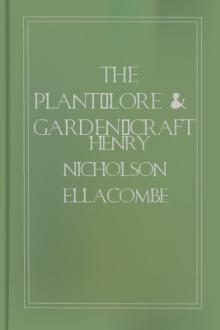The plant-lore & garden-craft of Shakespear, Henry Nicholson Ellacombe [read with me .TXT] 📗

- Author: Henry Nicholson Ellacombe
- Performer: -
Book online «The plant-lore & garden-craft of Shakespear, Henry Nicholson Ellacombe [read with me .TXT] 📗». Author Henry Nicholson Ellacombe
Though even as a fruit the Sloe had its value, and was not altogether despised by our ancestors, for thus Tusser advises—
Have thou in readines plentie of thoes,
And keepe them in bed-straw, or still on the bow,
To staie both the flix of thyselfe and thy cow."
As soon as the garden Plum was introduced, great attention seems to have been paid to it, and the gardeners of Shakespeare's time could probably show as good Plums as we can now. "To write of Plums particularly," said Gerard, "would require a peculiar volume. . . . Every clymate hath his owne fruite, far different from that of other countries; my selfe have threescore sorts in my garden, and all strange and rare; there be in other places many more common, and yet yearly commeth to our hands others not before knowne."
FOOTNOTES:[217:1] Omitted in the Globe edition.
[217:2] Bullein, in his "Government of Health," 1588, calls them "Damaske Prunes."
POMEGRANATE. (1) Lafeu. Go to, sir, you were beaten in Italy for picking a kernel out of a Pomegranate. All's Well that Ends Well, act ii, sc. 3 (275). (2) Juliet. It was the nightingale and not the lark,That pierced the fearful hollow of thine ear;
Nightly she sings on yon Pomegranate tree.[219:1] Romeo and Juliet, act iii, sc. 5 (2). (3) Francis. Anon, anon, sir, Look down into the Pomegarnet, Ralph. 1st Henry IV, act ii, sc. 4 (41).
There are few trees that surpass the Pomegranate in interest and beauty combined. "Whoever has seen the Pomegranate in a favourable soil and climate, whether as a single shrub or grouped many together, has seen one of the most beautiful of green trees; its spiry shape and thick-tufted foliage of vigorous green, each growing shoot shaded into tenderer verdure and bordered with crimson and adorned with the loveliest flowers; filmy petals of scarlet lustre are put forth from the solid crimson cup, and the ripe fruit of richest hue and most admirable shape."—Lady Calcott's Scripture Herbal. A simpler but more valued testimony to the beauty of the Pomegranate is borne in its selection for the choicest ornaments on the ark of the Tabernacle, on the priest's vestments, and on the rich capitals of the pillars in the Temple of Solomon.
The native home of the Pomegranate is not very certainly known, but the evidence chiefly points to the North of Africa. It was very early cultivated in Egypt, and was one of the Egyptian delicacies so fondly remembered by the Israelites in their desert wanderings, and is frequently met with in Egyptian sculpture. It was abundant in Palestine, and is often mentioned in the Bible, and always as an object of beauty and desire. It was highly appreciated by the Greeks and Romans, but it was probably not introduced into Italy in very early times, as Pliny is the first author that certainly mentions it, though some critics have supposed that the aurea mala and aurea poma of Virgil and Ovid were Pomegranates. From Italy the tree soon spread into other parts of Europe, taking with it its Roman name of Punica malus or Pomum granatum. Punica showed the country from which the Romans derived it, while granatum (full of grains) marked the special characteristic of the fruit that distinguished it from all other so-called Apples. Gerard says: "Pomegranates grow in hot countries, towards the south in Italy, Spaine, and chiefly in the kingdom of Granada, which is thought to be so named of the great multitude of Pomegranates, which be commonly called Granata."[220:1] This derivation is very doubtful, but was commonly accepted in Gerard's day.[220:2] The Pomegranate lives and flowers well in England, but when it was first introduced is not recorded. I do not find it in the old vocabularies, but a prominent place is given to it in "that Gardeyn, wele wrought," "the garden that so lyked me;"—
Of Pomgarnettys a fulle gret delle,
That is a fruit fulle welle to lyke,
Namely to folk whaune they ben sike."
Romaunt of the Rose.
Turner describes it in 1548: "Pomegranat trees growe plentuously in Italy and in Spayne, and there are certayne in my Lorde's gardene at Syon, but their fruite cometh never with perfection."[221:1]
Gerard had it in 1596, but from his description it seems that it was a recent acquisition. "I have recovered," he says, "divers young trees hereof, by sowing of the seed or grains of the height of three or four cubits, attending God's leisure for floures and fruit." Three years later, in 1599, it is noticed for its flowers in Buttes's "Dyet's Dry Dinner" (as quoted by Brand), where it is asserted that "if one eate three small Pomegranate flowers (they say) for a whole yeare he shall be safe from all manner of eyesore;" and Gerard speaks of the "wine which is pressed forth of the Pomegranate berries named Rhoitas or wine of Pomegranates," but this may have been imported. But, when introduced, it at once took kindly to its new home, so that Parkinson was able to describe its flowers and fruits from personal observation. In all the southern parts of England it grows very well, and is one of the very best trees we have to cover a south wall; it also grows well in towns, as may be seen at Bath, where a great many very fine specimens have been planted in the areas in front of the houses, and have grown to a considerable height. When thus planted and properly pruned, the tree will bear its beautiful flowers from May all through the summer; but generally the tree is so pruned that it cannot flower. It should be pruned like a Banksian Rose, and other plants that bear their flowers on last year's shoots, i.e., simply thinned, but not cut back or spurred. With this treatment the branches may be allowed to grow in their natural way without being nailed in, and if the single-blossomed species be grown, the flowers in good summers will bear fruit. In 1876 I counted on a tree in Bath more than sixty fruit; the fruits will perhaps seldom be worth eating, but they are curious and handsome. The sorts usually grown are the pure scarlet (double and single), and a very double variety with the flowers somewhat variegated. These are the most desirable, but there are a few other species and varieties, including a very beautiful dwarf one from the East Indies that is too tender for our climate out-of-doors, but is largely grown on the Continent as a window plant.
FOOTNOTES:[219:1] In illustration of Juliet's speech Mr. Knight very aptly quotes a similar remark from Russell's "History of Aleppo," adding that a "friend whose observations as a traveller are as accurate as his descriptions are graphic and forcible, informs us that throughout his journeys in the East he never heard such a choir of nightingales as in a row of Pomegranate trees that skirt the road from Smyrna to Bondjia."
[220:1] In a Bill of Medicines furnished for the use of Edward I. 1306-7, is—
Item pro vino malorum granatorun xx lb., lx s."
Archæological Journal, xiv, 27.
[220:2] See Prescott's "Ferdinand and Isabella," vol. iii. p. 346, note (Ed. 1849)—the arms of the city are a split Pomegranate.
[221:1] "Names of Herbes," s.v. Malus Punica.
POMEWATER, see Apple. POPERING, see Pear. POPPY. Iago. Not Poppy or Mandragora,Nor all the drowsy syrups of the world,
Shall ever medicine thee to that sweet sleep
Which thou ownedst yesterday. Othello, act iii, sc. 3 (330).
The Poppy had of old a few other names, such as Corn-rose and Cheese-bowls (a very old name for the flower), and being "of great beautie, although of evil smell, our gentlewomen doe call it Jone Silverpin." This name is difficult of explanation, even with Parkinson's help, who says it meanes "faire without and foule within," but it probably alludes to its gaudy colour and worthlessness. But these names are scarcely the common names of the plant, but rather nicknames; the usual name is, and always has been, Poppy, which is an easily traced corruption from the Latin papaver, the Saxon and Early English names being variously spelt, popig and papig, popi and papy; so that the Poppy is another instance of a very common and conspicuous English plant known only or chiefly by its Latin name Anglicised.
Our common English Poppy, "being of a beautiful and gallant red colour," is certainly one of the handsomest of our wild flowers, and a Wheat field with a rich undergrowth of scarlet Poppies is a sight very dear to the artist,[223:1] while the weed is not supposed to do much harm to the farmer. But this is not the Poppy mentioned by Iago, for its narcotic qualities are very small; the Poppy that he alludes to is the Opium Poppy (P. somniferum). This Poppy was well known and cultivated in England long before Shakespeare's day, but only as a garden ornament; the Opium was then, as now, imported from the East. Its deadly qualities were well known. Gower describes it—
Popy that bereth the sede of slepe."
Conf. Aman., lib. quint. (2, 102 Paulli).
Spenser speaks of the plant as the "dull Poppy," and describing the Garden of Proserpina, he says—
And trees of bitter gall, and Heben sad,
Dead-sleeping Poppy, and black Hellebore,
Cold Coloquintida."
F. Q., ii, 7, 52.
And Drayton similarly describes it—
Procuring deadly sleeping."
Nymphal v.
The name of opium does not seem to have been in general use, except among the apothecaries. Chaucer, however, uses it—
With necotykes, and opye of Thebes fyn."
The Knightes Tale.
And so does Milton—
Or medicinal liquor can asswage,
Nor breath of vernal air from Snowy Alp;
Sleep hath forsook and given me o'er
To death's benumming opium as my only cure."
Samson Agonistes.
Many of the Poppies are very ornamental garden plants. The pretty yellow Welsh Poppy (Meconopsis Cambrica), abundant at Cheddar Cliffs, is an excellent plant for the rockwork where, when once established, it will grow freely and sow itself; and for the same place the little Papaver Alpinum, with its varieties, is equally well suited. For the open border the larger Poppies are very suitable, especially the great Oriental Poppy (P. orientale) and the grand scarlet Siberian Poppy (P. bracteatum), perhaps the most gorgeous of hardy plants: while among the rarer species of the tribe we must reckon the Meconopses of the Himalayas (M. Wallichi and M. Nepalensis), plants of singular beauty and elegance, but very difficult to grow, and still more difficult to keep, even if once established; for though perfectly hardy, they are little more than biennials. Besides these Poppies, the large double garden Poppies are very showy and of great variety in colour, but they are only annuals.





Comments (0)